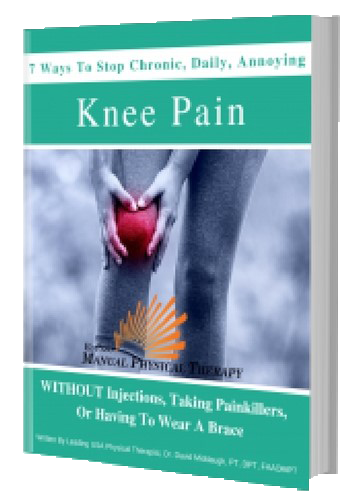TAP TO CALL (915) 503-1314

3 Things That Can Go Wrong If You Walk On A Failed Knee Replacement
There are three things that could go wrong if you’re walking on a failed knee replacement, I’m going to tell you those three things. But before I do that, let me just talk about what is a failed knee replacement.
Now, if you are in a wheelchair, you’ve been unable to use your leg at all the one that you had replacement on and your leg is very swollen, it’s very painful. You can’t sleep at night, and you’re probably desperate to have the thing taken out or replacement parts taken out and put in again, if you’re in that situation, and you go to the doctor, and they’re telling you yes, let’s do it.
That’s a definite failed knee replacement, now I’m not helping those people in this video, because you absolutely should not be walking on your knee if that’s the case, you need to go talk to a surgeon and see what they can do for you. I’m talking about the people that they can walk, but they hurt after they’ve been on their feet too long, they have some swelling, some pain if they do too much.
And they’re thinking that they might have a failed knee replacement, some would consider it a failed knee replacement because the knee replacement did not turn out like they hoped going into the surgery, they’re still dealing with some problems, sometimes just as bad as before the surgery and sometimes even worse than before the surgery.
Very often, they’re overall doing better from before surgery, but they’re still dealing with some discomfort. In that situation, people are wanting to avoid that knee problem from getting worse so that they can protect their knee replacement for the long term. So with that understanding, let’s get into the three things that can make it worse.
The first one is you can feed into a muscle imbalance. Now if you had a knee replacement that you had knee osteoarthritis before the surgery, that’s why you got the joint replaced. And what sets up knee osteoarthritis is too much pressure from the thigh muscles that end up compressing the knee joint.
And if you’ve never taken the time to deliberately correct the muscle imbalance, then chances are it still has not been corrected because the surgery doesn’t correct it, and rehabilitation, if you go through like physical therapy after the surgery, that also does not correct it.
This involves fixing the weakest muscles, which very usually comes from the glutes, and also from the foot muscles. And if those muscle groups have not been addressed, then chances are that you’re going to be using your thigh muscles way too much.
It’s a compensation whenever you go walking. And every time you take a step, you’re going to overuse the thigh muscles and add a lot of compression to your knee joints, which overtime is going to make the knee problem worse and worse. You don’t want to be walking on a failed knee replacement and a painful knee replacement.
If you have not addressed the muscle imbalance. Number two is you’re going to loosen the hardware. If you already are having pain, swelling, discomfort, and you probably have this muscle imbalance I’m talking about. If you continue to walk on it, you’re going to put excessive pressures through the knee joint, eventually it can loosen the hardware, it can break the cement that was used to attach the hardware to the bone.
If you had a cemented surgery it can crack the cement. And if you didn’t have a cemented surgery, you had what’s called a bone interface surgery, then that area can be loosened as well. The plastic chunk that’s put between the two ends of the bone can also be affected. Choosing to walk through pain and discomfort or if you get pain and discomfort after you walk like later on that day or the next day. And you know that it’s going to come on the next time you go walking.
That’s not a good idea. Because you’re going to mess with the hardware, you’re just going to create a worse situation over time. And number three is you can get other injuries to your knee that are more common injuries. I’m talking about things like strains, sprains, tendinitis, bursitis and nerve injuries.
Because of that muscle imbalance, it’s going to pull on the other tissues and all those tissues I talked about the ligaments, the tendons, the nerves, the muscles, and it’s going to irritate them, you’re not putting normal pressures through your knee joints if you have this muscle imbalance if you’ve never addressed it, and it’s just a matter of time, that as you start to walk more and more, it’s going to hurt it, which is going to set you up to walk differently to compensate with your other leg and to eventually injure your knee replacement.
And I’ve got lots of videos to help to correct this muscle imbalance and to help with other issues that deal with knee replacements. If you check out the description below you’ll find a playlist a link to a playlist called the Knee Replacement Pain Help playlist and they’ve also got a comprehensive online program called the Failed Knee Replacement Recovery Program.
There’s a link that you can learn more about it in the description below as well. Hey, if this video was helpful for you, please give us a thumbs up. Please share this with somebody that you think needs to see this, subscribe to our channel and turn on our notification bell so that you don’t miss out on any of the helpful videos that we post each and every week. Thanks so much for watching. I’ll see you in the next video. Bye bye!
Would You Like To Talk With A Specialist?
Appointments and Questions Call: (915)503-1314
EL PASO MANUAL PHYSICAL THERAPY
2601 E. Yandell Drive, Suite 232
El Paso, Texas 79903
© 2023 El Paso Manual Physical Therapy, PLLC, All Rights Reserved
